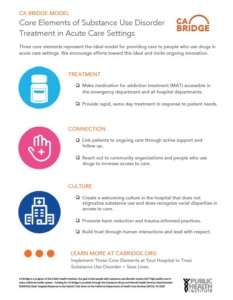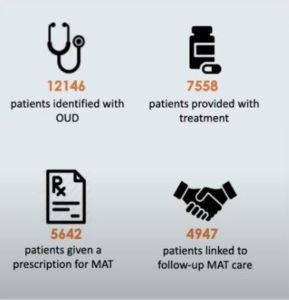Highlights

In 2018, CA-Bridge’s opioid and substance abuse treatment model began, in just eight hospitals. By mid-2020, more than 200 hospitals, about ⅔ of all hospitals in California, adopted their model for substance abuse treatment. The move follows the CA Bridge program’s demonstrated success in 52 hospitals across California over the past two years.
200+ hospitals in California adopted the CA Bridge model in 2020
52 hospitals piloted the CA Bridge model for opioid and substance abuse treatment between 2018-2020
12K patients were identified with opioid use disorder
7.5K patients were provided with treatment in the hospitals
5.6K patients were prescribed medication for addiction treatment
4.9K patients were linked to follow-up care
-
Focus Areas
Alcohol, Tobacco, Drugs & Mental Health, Health Care & Population Health -
Expertise
Public-Private Partnerships -
Strategic Initiatives
Opioids
It can often take decades to change the culture and treatment practices across large healthcare systems. So the success of PHI’s CA Bridge program is truly remarkable: beginning in just eight hospitals in 2018, by mid-2020 a $20 million pilot project with the California Department of Health Care Services (DHCS) funded more than 200 hospitals, about ⅔ of all hospitals in California, to adopt the CA Bridge model for substance use treatment.
For decades, hospital practices have stigmatized patients with substance use disorders and often fail to provide any hospital-based treatment. People with substance use disorders coming to hospital emergency rooms would typically be given little more than referrals to outpatient treatment programs, and little or no follow-up to see if they were able to access care.
The CA Bridge program was founded to ensure that people with substance use disorder receive 24/7 high-quality care in every California health system by 2025. The approach fully integrates addiction treatment into standard medical practice–even when patients aren’t coming in for substance-related issues–thereby increasing access to treatment and saving lives.

The CA Bridge approach is comprised of three core elements for providing hospital-based care to people who use drugs:
- Treatment: making evidence-based substance use disorder treatment (medication for addiction treatment or “MAT”) accessible in the emergency department and in all other hospital departments. Treatment is provided rapidly & efficiently in response to patient needs.
- Connection: Linkage to ongoing care involves active support and follow up with patients. Outreach to people who use drugs aims to increase access to care, equity, & harm reduction.
- Culture: Hospital culture is welcoming and does not stigmatize substance use. Human interactions that build trust are integral to how substance use disorder treatment is provided.
“There was a dramatic shift in the culture in the emergency room. Instead of the team feeling frustrated and letting that show when the patients arrived with concerns or side-effects related to substance use disorders, they were instead excited to identify them as someone who would be a part of our program. I feel this program gave our team the tools they needed to actually help people with this need, and once they had the tools, it brought them joy to help them.”
A hospital emergency room physician
From the initial eight hospitals in 2018, CA Bridge expanded to fifty-two hospitals across the state, and began demonstrating the success of their approach on a larger scale. By June 2020, the fifty-two  hospitals reported:
hospitals reported:
- more than 12,000 patients had been identified with opioid use disorder
- more than 7,500 patients were provided with treatment in the hospitals
- more than 5,600 patients were prescribed medication for addiction treatment (MAT), and
- nearly 5,000 patients were linked to follow-up care.
“One of the big surprise ‘aha moments’ was how transformational [the program] is not just for the patients, but for the staff, the nurses and doctors. It is a way to bring meaning back into medicine.”
Kelly Pfeifer, MD, deputy director of mental health and substance use disorder services, California Department of Health Care Services.
Having the CA Bridge program in hospitals also creates ripples throughout the community. Among the 52 pilot hospitals there are:
- 37 collaborating with local EMS for addiction treatment
- 38 collaborating with local law enforcement
- 40 acting as training and mentoring sites for other regional hospitals
- 47 collaborating with local harm reduction organizations
See the August 2020 press release and more impacts from the CA Bridge program on their website.
Work With Us
You change the world. We do the rest. Explore fiscal sponsorship at PHI.
Support Us
Together, we can accelerate our response to public health’s most critical issues.
Find Employment
Begin your career at the Public Health Institute.
